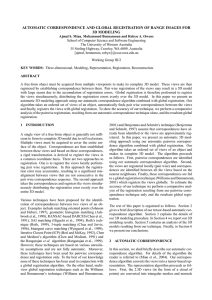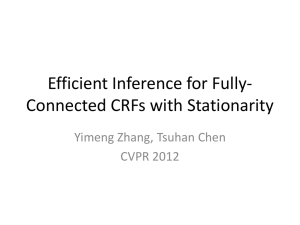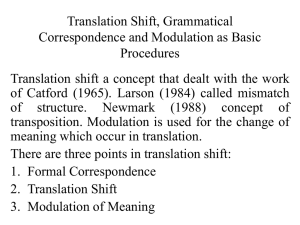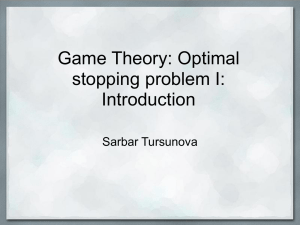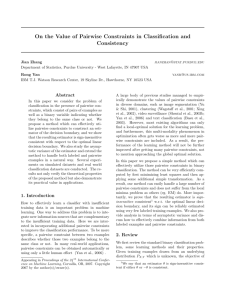here
advertisement
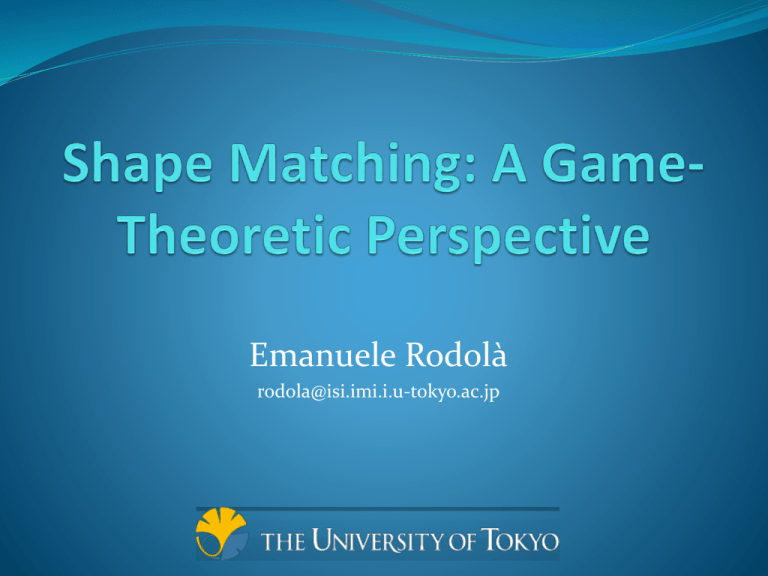
Emanuele Rodolà rodola@isi.imi.i.u-tokyo.ac.jp Born + Engineering in Rome Born + Engineering in Rome Born + Engineering in Rome Computer Vision in Venice Research in Tel Aviv (Israel) Research in Tel Aviv (Israel) Research in Tel Aviv (Israel) Research in Tel Aviv Correspondence Problem We are given a pair of objects Correspondence Problem We are given a pair of objects We assume these objects represent the same entity to some extent Correspondence Problem We are given a pair of objects We assume these objects represent the same entity to some extent Our task is to find feature-wise correspondences between the objects Correspondence Problem We are given a pair of objects We assume these objects represent the same entity to some extent Our task is to find feature-wise correspondences between the objects Correspondence Problem We are given a pair of objects We assume these objects represent the same entity to some extent Our task is to find feature-wise correspondences between the objects Real-world examples Real-world examples Related Work Most traditional techniques are feature-based Local descriptors (e.g. SIFT) are associated to object points Consensus/voting approaches are applied to extract a set of likely hypotheses RANSAC-Based Darces: A New Approach to Fast Automatic Registration of Partially Overlapping Range Images. C.Chen, Y.Hung, J.Cheng. TPAMI 1999 Related Work Other effective techniques exploit specific information from their applicative domain (e.g. plane matching) 4-Points Congruent Sets for Robust Pairwise Surface Registration. D.Aiger, N.Mitra, D.Cohen-Or. SIGGRAPH 2008 Resorting to Pairwise Constraints Resorting to Pairwise Constraints Resorting to Pairwise Constraints Resorting to Pairwise Constraints Resorting to Pairwise Constraints Resorting to Pairwise Constraints Resorting to Pairwise Constraints The correspondence problem can be formulated as an assignment problem in which each pair of assignments is given an agreement weight The solution to the assignment problem is the set of assignments giving the maximum possible agreement Problem formulation Given a set of nM model features M and a set of nD data features D, a correspondence mapping C is a set of pairs (i, i' ) S M D . For each pair of assignments (a, b) S S there is an associated pairwise affinity measure Given n candidate assignments, the affinity measures can be materialized in a n n affinity matrix Pairwise affinity (a, b) describes how well the relative pairwise geometry (or any type of pairwise relationship) of two model features (i, j ) is preserved after putting them in correspondence with the data features (i' , j ' ) . π:S S R , π i, i', j, j ' e λ i j i ' j ' 2 Quadratic Assignment Problem The correspondence problem reduces to finding the cluster C of assignments (i, i ' ) with maximum score ( a , b ) a ,bC Quadratic Assignment Problem We can represent any cluster C by an indicator vector n x 0,1 such that x(a) 1 if a C and zero otherwise. The inter-cluster score can be rewritten as T ( a , b ) x x a ,bC The optimal solution x* is the binary vector x* arg max(xT x) The resulting Integer Quadratic Program is NP-Hard Problem Relaxation The binary constraint on x can be relaxed to give rise to a fuzzy notion of correspondence, in which x 0,1 x*(a) may be interpreted as a measure of association of a with the best cluster C* Since only the relative values between the elements of x matter, we can impose x 1 We arrive at the quadratic problem max xT x s.t. x 1, x 0,1 n n A spectral solution max xT x s.t. x 1, x 0,1 n By Rayleigh’s quotient theorem, x* maximizing the score is the principal eigenvector of Finally, since 0 , by Perron-Frobenius theorem the elements of x* will have the same sign and be in 0,1 A spectral solution (cont’d) The spectral approach turns out to be inefficient and to have stability issues in the presence of outliers A Spectral Technique for Correspondence Problems Using Pairwise Constraints. M.Leordeanu, M.Hebert. ICCV 2005 An inlier selection approach 1 We cast the matching problem to an inlier selection problem in which we are interested in few, stable inliers even under strong outlier noise. 0.5 0 0 10 20 30 40 50 60 70 0 10 20 30 40 50 60 70 80 90 100 1 0.5 0 80 90 100 Attaining sparsity Following a sparsity ansatz found in signal processing, we propose to further relax the constraints on x, arriving at: max xT x s.t. x 1, x 0,1 L1 n Thus, we are seeking to optimize xT x over the standard n-simplex n n n x R : i xi 0, xi 1 i 1 Game Theory in Computer Vision Originated in the early 40’s, Game Theory was an attempt to formalize a system characterized by the actions of entities with competing objectives, which is thus hard to characterize with a single objective function. According to this view, the emphasis shifts from the search of a local optimum to the definition of equilibria between opposing forces. Game Theory (cont’d) Multiple players have at their disposal a set of strategies and their goal is to maximize a payoff (or reward) that depends on the strategies adopted by other players. Preliminaries Let O 1,, n enumerate the set of available pure strategies, our candidate matches (i, i ' ) S Let ( ij ) specify the payoffs among i- and jstrategists A mixed strategy x n is a probability distribution over the set of strategies The support of a mixed strategy x, denoted by σ(x), is defined as the set of elements chosen with non-zero probability: ( x) i O | xi 0. Expected payoff The expected payoff received by a player choosing element i when playing against a player adopting a mixed strategy x is ( x ) i j i j x j . The expected payoff received by adopting the mixed strategy y against x is yT x . Nash Equilibria The best replies against mixed strategy x: ( x) y n | yT x maxz zT x A central notion is that of a Nash Equilibrium. A strategy x is said to be a NE if it is a best reply to itself, i.e. y n , xT x yT x , implying: i ( x), ( x)i xT x Evolutionary Dynamics We undertake an evolutionary approach to the computation of Nash equilibria. We consider a scenario where pairs of individuals are repeatedly drawn at random from a large population to perform a two-player game. A selection process operates over time on the distribution of behaviors, favoring players that receive higher payoffs. Evolutionary Stable Strategies In this dynamic setting, the concept of stability, or resistance to invasion by new strategies, becomes central. A strategy x is said to be an evolutionary stable strategy (ESS) if it is a NE and y n , xT x yT x xT y yT y This condition guarantees that any deviation from the stable strategies does not pay. A link with Optimization Theory Stable states correspond to the strict local maximizers of the average payoff xT x over the simplex, whereas all critical points are related to Nash Equilibria The selection process The search for a stable state is performed by simulating the evolution of a natural selection process. Many algorithms with different mathematical properties have been proposed in literature. Replicator Dynamics ( x(t ))i xi (t 1) xi (t ) T x(t ) x(t ) Under this dynamics, the average payoff of the population is also guaranteed to strictly increase (provided the matrix is nonnegative and symmetric), and x(t+1) = x(t) only when x is a stationary point for the dynamics. Replicator Dynamics ( x(t ))i xi (t 1) xi (t ) T x(t ) x(t ) The fraction of individuals adopting strategy i will grow over time whenever their expected payoff exceeds the population average, decreasing otherwise. Any such sequence will always converge to a unique solution (a Nash Equilibrium). Very simple implementation and rather efficient Biologically motivated The Matching Game Define the set of strategies available to the players Define the payoffs related to these strategies (payoff matrix) by means of some payoff function Initialize the population vector (e.g., at the barycenter of the simplex) Run the evolutionary process until an equilibrium is reached Object-in-clutter recognition The inlier selection behavior finds a direct application in object-in-clutter recognition A Scale-Independent Selection Process for 3D Object Recognition in Cluttered Scenes. E.Rodolà, A.Albarelli, F.Bergamasco, A.Torsello. 3DIMPVT 2011, IJCV 2012 (to appear). Rigid surface alignment Fast and Accurate Surface Alignment Through an Isometry-Enforcing Game. A.Albarelli, E.Rodolà, A.Torsello. CVPR 2010, TPAMI 2012 (to appear). Feature detection Adopting single local features as game strategies gives rise to an effective clustering approach Loosely Distinctive Features for Robust Surface Alignment. A.Albarelli, E.Rodolà, A.Torsello. ECCV 2010. Feature matching for SfM We can enforce an affine or epipolar (instead of isometric) constraint to match SIFT-like features Imposing Semi-local Geometric Constraints for Accurate Correspondences Selection in SfM. A.Albarelli, E.Rodolà, A.Torsello. 3DPVT 2010, IJCV 2012. Matching non-rigid shapes Matching non-rigid shapes Resilience to different kinds of deformation depends on the specific choice of a metric d*() on the shapes. Just like in the rigid case, we are going to enforce isometries of the shapes according to some payoff/affinity function π. πi, i' , j, j' e λ d M (i , j )d D (i ', j ') Experimental results Qualitative results A Game-Theoretic Approach to Deformable Shape Matching. E.Rodolà, A.Bronstein, A.Torsello. CVPR 2012. Conclusions We approached the all-pervasive correspondence problem in Computer Vision. o Our main results took advantage of recent developments in the emerging field of game-theoretic methods for Machine Learning and Pattern Recognition. We shaped a general framework that is flexible enough to accommodate rather specific and commonly encountered correspondence problems within the areas of 3D reconstruction and shape analysis. o We were able to apply said framework to a non-rigid 3D matching scenario and tested its effectiveness. Future directions Perform a probabilistic analysis of the framework and its selection process Introduce a space-regularization term over the set of correspondences Investigate the links with optimization theory A fast GPU implementation would allow us to consider higher-order matching problems (anybody interested?) Thank you! Questions?

